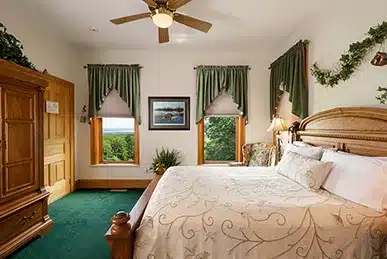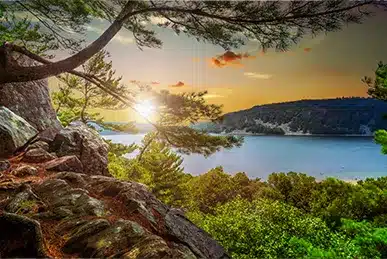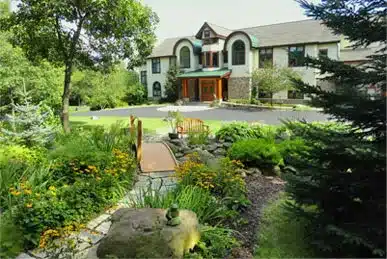The first two weeks of November are peak bird migration and a great time to visit the Inn at Wawanissee Point bed and breakfast nestled in the Baraboo Hills Important Bird Area, which has essential habitat that hosts more than 135 breeding bird species and is a key stopover area during migration.
- As the temperature dips, days shorten and leaves are falling, hiking and birding in November are more peaceful as fewer people think to visit.
Come see the oaks dressed in an array of rusts to burgundy while the forest floor is aglow with a carpet of leaves. After dark enjoy theatre and musical performances, or snuggle by our secluded prairie terrace campfire to watch four concurrent meteor showers, three with peaks Nov. 4-18, 2017.
Book a final fall-color frolic HERE or call us at 608-355-9899.
Monitor the changing fall colors in the Baraboo Bluffs by visiting the Inn’s Live Web Cam at the bottom of our home page at www.bestviewinwisconsin.com.
Prepare For November Hiking
November weather can be cloudy, damp and cool, but it also surprises us with bursts of warm, sunny days.
- There’s no such thing as bad weather only improper clothing!
Invest in comfortable, quality gear so nothing impedes you from the stress-relieving benefits and joy of hitting the trail and soaking in crisp, fall air and solitude.
What To Wear
Dress in breathable, insulating layers. Carry a small backpack to stow layers when the sun’s peeking out, plus a thermos of tea or coffee, snacks, camera, binoculars and your birding notebook.
- Base layer: wicking long underwear tops and bottoms of wool, silk or synthetic materials under hiking pants. No cotton. Tops with long sleeves and zip necks give you maximum versatility. Form fitted lets you add layers without restriction. Browse long-sleeved cycling jerseys and running shirts, and base layers in online outfitters like REI. A light-weight plus heavier version can be your base and middle layers.
- Hiking pants of a quick-drying, durable material like nylon, nylon-spandex blends or other synthetic material. No denim.
- Middle layer for your top of not-too-bulky wool or fleece for when it’s colder. For warmer days skip it and use only a vest.
- Insulating vest: over the base layer, or base and middle layer, of fleece or a down- or synthetic filled nylon or other like material to keep your core warm but your arms free to run the binoculars and camera.
- Waterproof shell that is lightweight, breathable and covers all the layers for all season. On really warm days wear it over the base layer alone. It will retain some heat. Look for pit zips or vented gussets if you tend to overheat. Hoods offer the most versatility. Some will pack into a pocket to fit easily in a fanny pack or backpack so it’s ready when you need it. A jacket that reaches the hips or a little lower sheds more water when its raining and doesn’t bunch up if you wear a backpack.
- Waterproof hiking boots with wool socks. Again, no cotton. Wool socks are supreme for all seasons; it breathes and wicks keeping your skin dry.
- Waterproof gloves, with or without a liner or insulation, that aren’t too bulky so you can operate the binocs and camera swiftly. And your favorite hat of wool or fleece.
- Sunglasses and sunscreen lip balm.
Where To Hike And See Birds
1. Our 42 acres of prairie and woods with three miles of groomed trails.
2. Adjacent to us Parfrey’s Glen State Natural Area with access to the Ice Age Trail west to Devil’s Lake State Park.
3. Two miles from here the Riverland Conservancy Merrimac Preserve’s 1,900 acres of forest, prairie, savanna, wetlands and streams laced with 12.7 miles of trails, including 3.2 miles of Ice Age Trail that connect to Devil’s Lake State Park.
4. Devil’s Lake State Park and the two State Natural Areas within it, Devil’s Lake Oak Forest and South Bluff/Devil’s Nose State Natural Area, are considered one of state’s top 10 birding sites by the Wisconsin Society for Ornithology. For the nature reports from the park visit its blog at www.devilslakewisconsin.com
5. The Fairfield Marsh U.S. Fish & Wildlife Service (FWS) Waterfowl Production Area along State Hwy 33 and the Baraboo River east of Baraboo. Observe 238 acres from the kiosk in the small parking area.
6. Crane congregation tours at the Aldo Leopold Center in late October and early November to see thousands of sandhill cranes staging on the Wisconsin River’s sandbars and islands along the Leopold-Pine Island Important Bird Area. Learn about here.
7. The Aldo Leopold Center’s 2.5-mile trail through 305 acres of oak savanna, wetlands and a dry prairie remnant overlooking the Wisconsin River, critical habitat for grassland birds and sandhill crane staging during migration, 20 minutes from the Inn.
8. Baxter’s Hollow State Natural Area, 30 minutes west of the Inn. An extensive tract of deep forest with a gorge cut through the Baraboo quartzite by Otter Creek, a mountain-like stream.
9. 40 minutes west of the Inn into the heart of Sauk County where the glaciated landscape meets the driftless is outstanding birding at Natural Bridge State Park and Natural Area, and Honey Creek, Pine Hollow and Hemlock Draw State Natural Areas (SNA). The Honey Creek SNA has hosted as many as 180 bird species, besides 500 native plants. The SNAs don’t have groomed trails, often a primitive footpath and more challenging hiking, but the habitat and discoveries make it worthwhile. Take a map of the SNA and a compass.
Bird By Car
- Rustic Road 21—Slotty, Orchard, Schara and Ruff Roads—winding through four SNAs (#9 above) and scenic working land.
- Along the dead-end Stone Pocket Road, slightly east of RR 21, to Baxter’s Hollow State Natural Area (#8 above).
- Nine miles of Rustic Road 49, Levee Road, along Leopold-Pine Island IBA. (see #6 above).
The best viewing opportunities are usually at dawn and dusk, and if you can sit in one spot quietly for a while.
- Late October before Daylight Savings ends: sunrise 7:30 a.m. and sunset 5:45 p.m.
- Early November after turning the clock back, sunrise 6:40 a.m. and sunset at 4:45 p.m.



